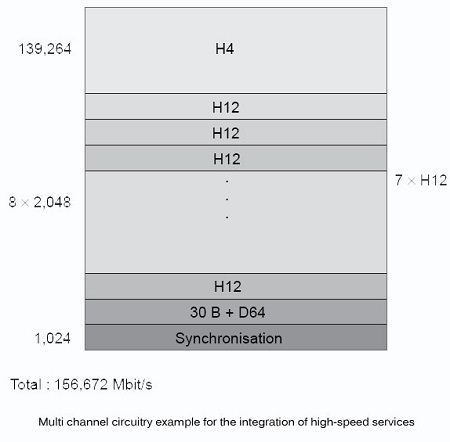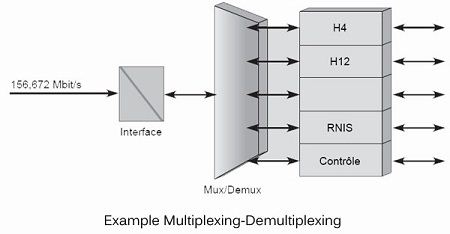To achieve simultaneous multiplexing multiple telephone lyrics on the same circuit, Americans have adopted a standard for multiplexing 24 channels of 64 kbit/s on a support at 1544 Kbit / s. This channel is called DS-1. Europeans have responded to this technique by the E-1 channel multiplexing 30 voice channels on a support 2048 Mbit/s. From this basic multiplexing, a hierarchy has been defined, it is a multiple of the base channel, as in the case of Europe, or a little more complex, as in the US case, because an area of supervision rate-dependent.
These hierarchies are called PDH (Plesiochronous Digital Hierarchy). the hierarchy European is as follows:
• E-1 = 2 Mbit/s
• E-2 = 8 Mbit/s
• E-3 = 34 Mbit/s
• E-4 = 140 Mbit/s
• E-5 = 565 Mbit/s
The US hierarchy is similar but less regular. It does not correspond to a multiple of the base channel because sync bits are not proportional to the number of channels carried. The root of plesiochronous plesio comes from Greek and means almost.
Physical media being passed in digital mode, a specific hierarchy has been developed under the name of SDH (Synchronous Digital Hierarchy) and SONET in Europe (Synchronous Optical Network) in North America. This new hierarchy still considers the digitization of speech with sampling every 125 microseconds, but is completely synchronous. A frame with a length depending on the speed, is issued every 125 microseconds. SONET and SDH are the two techniques used to route digital transmissions as different as speech and data. This technique can therefore carry all types of packets or frames, frame ATM, IP packet, Ethernet frame, etc.
SONET is a standard interface by ANSI (American National Standards Institute), the North American standards body. Its role was initially to introduce a large number of telephone channels on a single physical medium so as to interconnect the networks of two operators.
SDH is a standard generalization of SONET by ITU-T, which gives a definition of the data area which passes through the interface much more precise than that introduced into SONET. This data area carries the container name.
PDH (Plesiochronous Digital Hierarchy)
The standard PDH (pronounced plee-see-AH-krun-us, from Greek plesos, meaning close, and chronos, meaning time), that is to say, almost synchronous, was defined by the standardization bodies concerned with the phone to transit simultaneously on the same physical line several telephone channels. The terms “almost synchronous” indicate that this hierarchy works synchronously. However, the start time of the communication is asynchronous. In other words, communication is synchronous, once the start time decided.
Channels of different data rates are defined:
• B channel circuit 64 Kbit/s, which corresponds to a telephone channel.
• H0: channel circuit 384 Kbit/s, which represents a superposition of 6 channels B.
• H11: Circuit-channel 1472 kbit/s, that is to say an overlay of 23 B channels
• H12: Circuit-channel 1920 kbit/s, that is to say an overlay of 30 B channels
• H2: channel to 6.312 Mbit/s or 8.448 Mbit/s.
• H3: Channel at 32.064 Mbit/s or 34.368 Mb/s or 44.736 Mbit/s.
• H4: channel at 97.728 Mbit/s or 139,264 Mbit/s.
Another solution, which was developed without being normalized, consists of superimposing different types of circuits. In particular, the multi-circuit shown in Figure 14.2 has often been cited as a reference for the integration of services at very high speeds. This multi-circuit is a superposition of ten routes: H4 circuit seven circuits H12 and both B-channels were added to this superposition circuit’s D channel, multipoint packet switching channel, and a synchronization channel. In total, so there are twelve circuits that must pass simultaneously on the multi-circuit.

The main difficulty of this multi-circuit lies in the management of multipoint circuit. We must develop a single user interface capable of multiplexing data from different sources and demultiplexing in the opposite direction.
The figure illustrates this multiplexing. On the right lane comes a flood at 156.672 Mbit/s. This stream must be broken down into ten sub-streams, plus information control and synchronization. In the opposite direction, the twelve waves arriving simultaneously at the multiplexer must find their place on binding to 156.672 Mbit/s. This involves a series connection of the binary elements. In other words, the bits arriving together on the multiplexer must be placed one behind the other.

Channel multiplexing management is complex, resulting in the loss of part of the bandwidth for reasons other than the data transmission. The multi-circuit switching is the technique used in ISDN narrowband. In the basic interface, it provides the user with two B channels at 64 Kbit/s, which must be shared between the user terminal equipment: handset, PC, fax, videotext terminal, etc.
 Dinesh Thakur holds an B.C.A, MCDBA, MCSD certifications. Dinesh authors the hugely popular
Dinesh Thakur holds an B.C.A, MCDBA, MCSD certifications. Dinesh authors the hugely popular